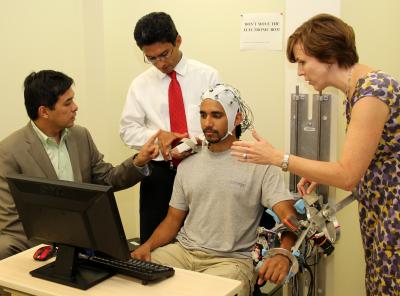By Kalwinder KaurAug 22 2012
Rice University, the University of Houston (UH) and TIRR Memorial Hermann have collaborated on a research that focuses on rapid and complete recovery of stroke survivors. This initiative is supported with a $1.17 M grant from the President's National Robotics Initiative (NRI) and the National Institutes of Health (NIH).
 From left, Gerard Francisco, José Luis Contreras-Vidal and Marcia O'Malley work with a University of Houston graduate student testing MAHI-EXO II, a robotic rehabilitation device developed at Rice
From left, Gerard Francisco, José Luis Contreras-Vidal and Marcia O'Malley work with a University of Houston graduate student testing MAHI-EXO II, a robotic rehabilitation device developed at Rice
The team involving multidisciplinary researchers anticipates integrating a noninvasive brain-machine interface (BMI) to a robotic orthotic device promoting advancement of upper-limb rehabilitation. Interpretation of brain waves can be achieved using this novel neurotechnology, through which a stroke patient can voluntarily maneuver an exoskeleton enveloping the patient’s arm from the elbow to fingertips.
Rice researchers are devising the exoskeleton, while UH is developing the electroencephalograph-based (EEG) neural interface. UTHealth physicians at TIRR Memorial Hermann will verify this integrated device.
Led by Professor José Luis Contreras-Vidal, the team was the first to succeed in reconstructing 3-D hand and walking motions from brain signals recorded in a an EEG brain cap noninvasively. Using this novel technology, users can control and better handle the movement of neuroprosthetic limbs using their intellect, robotic legs and below-elbow amputees. This new project focused on designing a BMI system for stroke survivors is a unique initiative.
Operation of the MAHI-EXO II robot begins by translation of brain waves from healthy subjects into control outputs through EEG devices. Stroke survivors who are to some extent capable of initiating movements can propel the robot into action. The EEG-robot interface will be honed by researchers prior to being used by stroke patients without residual upper-limb function.
When activated, the intelligent exoskeleton can stimulate repetitive motions and activate the brain's motor networks, using thoughts. A previous version of the MAHI-EXO II developed by O'Malley integrates sophisticated feedback that enables the patient to work rigorously while the robot gently assists or resists the motion accordingly.
Disclaimer: The views expressed here are those of the author expressed in their private capacity and do not necessarily represent the views of AZoM.com Limited T/A AZoNetwork the owner and operator of this website. This disclaimer forms part of the Terms and conditions of use of this website.